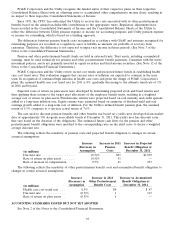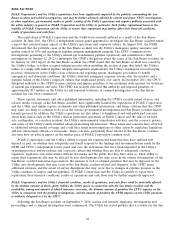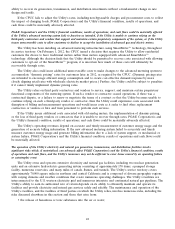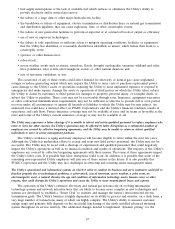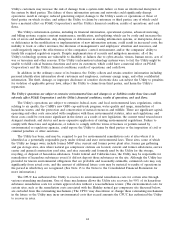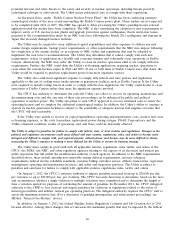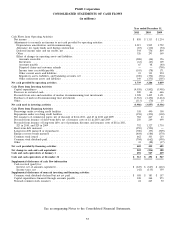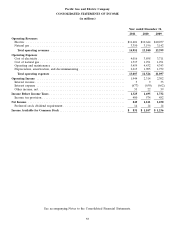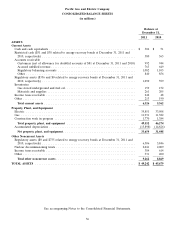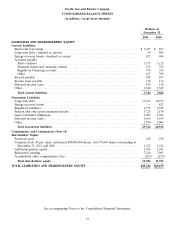PG&E 2011 Annual Report Download - page 51
Download and view the complete annual report
Please find page 51 of the 2011 PG&E annual report below. You can navigate through the pages in the report by either clicking on the pages listed below, or by using the keyword search tool below to find specific information within the annual report.Pipeline and Hazardous Materials Safety Administration (‘‘PHMSA’’) for violation of federal pipeline safety
regulations from $100,000 to $200,000 for an individual violation and from $1,000,000 to $2,000,000 for a series of
violations.
The Utility must comply with federal electric reliability standards that are set by the North American Electric
Reliability Corporation and approved by the FERC. These standards relate to maintenance, training, operations,
planning, vegetation management, facility ratings, and other subjects. These standards are designed to maintain the
reliability of the nation’s bulk power system and to protect the system against potential disruptions from cyber-
attacks and physical security breaches. Under the Energy Policy Act of 2005, the FERC can impose penalties (up to
$1 million per day, per violation) for failure to comply with these mandatory electric reliability standards. As these
and other standards and rules evolve, and as the wholesale electricity markets become more complex, the Utility’s
risk of noncompliance may increase.
In addition, statutes, regulations, rules, tariffs, and orders may become more stringent and difficult to comply
with in the future, or their interpretation and application may change such that the Utility will be determined to have
not complied with such new interpretations. If this occurs, the Utility could be exposed to increased costs to comply
with the more stringent requirements or new interpretations and to potential liability for customer refunds, penalties,
or other amounts. If it is determined that the Utility did not comply with applicable statutes, regulations, rules,
tariffs, or orders, and the Utility is ordered to pay a material amount in customer refunds, penalties, or other
amounts, PG&E Corporation’s and the Utility’s financial condition, results of operations, and cash flows would be
materially affected.
The Utility also must comply with the terms of various permits, authorizations, and licenses. These permits,
authorizations, and licenses may be revoked or modified by the agencies that granted them if facts develop that
differ significantly from the facts assumed when they were issued. In addition, discharge permits and other approvals
and licenses often have a term that is less than the expected life of the associated facility. Licenses and permits may
require periodic renewal, which may result in additional requirements being imposed by the granting agency. In
connection with a license renewal for one or more of the Utility’s hydroelectric generation facilities or assets, the
FERC may impose new license conditions that could, among other things, require increased expenditures or result in
reduced electricity output and/or capacity at the facility.
If the Utility cannot obtain, renew, or comply with necessary governmental permits, authorizations, or licenses,
or if the Utility cannot recover any increased costs of complying with additional license requirements or any other
associated costs in its rates in a timely manner, PG&E Corporation’s and the Utility’s financial condition and results
of operations could be materially affected.
Market performance or changes in other assumptions could require PG&E Corporation and the Utility to make significant
unplanned contributions to its pension plan, other postretirement benefits plans, and nuclear decommissioning trusts.
PG&E Corporation and the Utility provide defined benefit pension plans and other postretirement benefits for
eligible employees and retirees. The Utility also maintains three trusts for the purposes of providing funds to
decommission its nuclear facilities. Up to approximately 60% of the plan assets and trust assets have generally been
invested in equity securities, which are subject to market fluctuation. A decline in the market value may increase the
funding requirements for these plans and trusts.
The cost of providing pension and other postretirement benefits is also affected by other factors, including the
assumed rate of return on plan assets, employee demographics, discount rates used in determining future benefit
obligations, rates of increase in health care costs, levels of assumed interest rates, future government regulation, and
prior contributions to the plans. Similarly, funding requirements for the nuclear decommissioning trusts are affected
by changes in the laws or regulations regarding nuclear decommissioning or decommissioning funding requirements,
changes in assumptions as to decommissioning dates, technology and costs of labor, materials and equipment change,
and assumed rate of return on plan assets. For example, changes in interest rates affect the liabilities under the
plans: as interest rates decrease, the liabilities increase, potentially increasing the funding requirements.
The Utility has recorded an asset retirement obligation related to decommissioning its nuclear facilities based on
various estimates and assumptions. Changes in these estimates and assumptions can materially affect the amount of
the recorded asset retirement obligation.
The CPUC has authorized the Utility to recover forecasted costs to fund pension and postretirement plan
contributions and nuclear decommissioning through rates. If the Utility is required to make significant unplanned
contributions to fund the pension and postretirement plans and nuclear decommissioning trusts and is unable to
47


